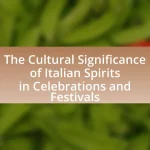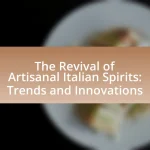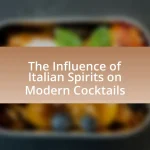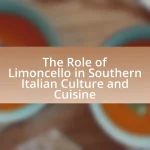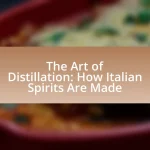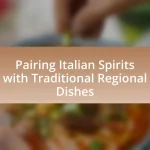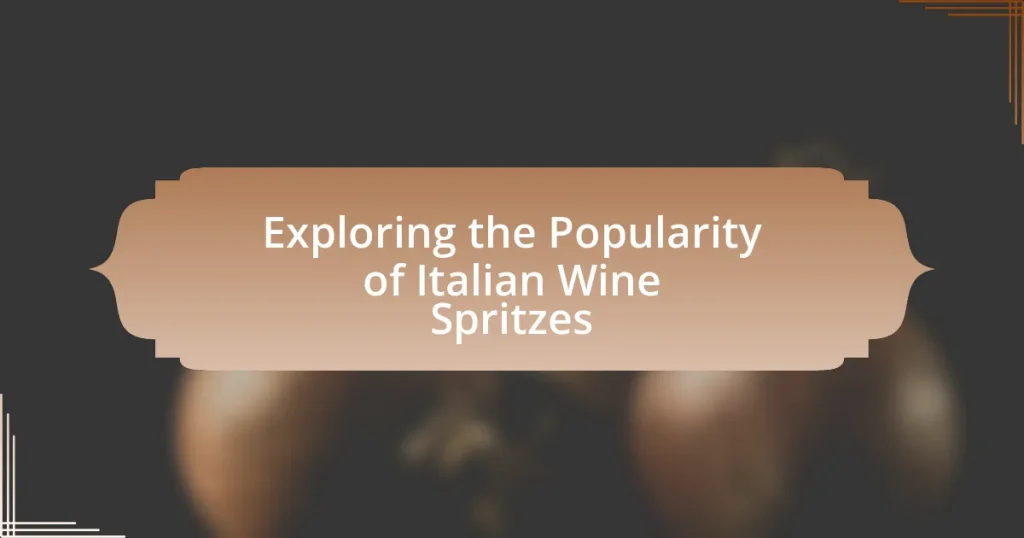Italian Wine Spritzes are refreshing cocktails originating from the Veneto region of Italy, typically made with Prosecco, a bitter liqueur like Aperol or Campari, and soda water. This article explores the historical evolution of the Spritz, its cultural significance in Italian aperitivo traditions, and the various ingredients and regional variations that contribute to its popularity. Additionally, it examines the impact of social media on the drink’s global appeal and offers insights into crafting the perfect Italian Wine Spritz, including tips for enhancing flavor and presentation. The article also highlights innovative twists and seasonal ingredients that can be incorporated into this iconic beverage.
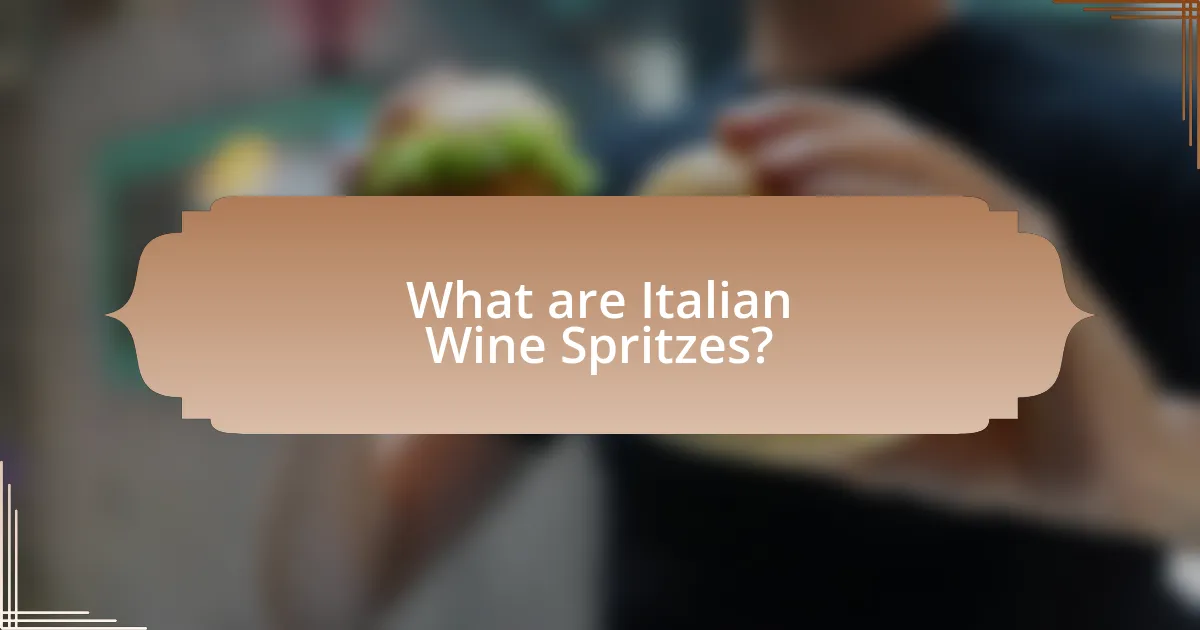
What are Italian Wine Spritzes?
Italian Wine Spritzes are refreshing cocktails typically made with a base of Italian wine, such as Prosecco, combined with a bitter liqueur like Aperol or Campari, and topped with soda water. This drink originated in Italy and has gained popularity for its vibrant flavor and appealing presentation, often garnished with an orange slice or olive. The combination of wine and bitters creates a balanced taste that is both sweet and slightly bitter, making it a favored choice for social gatherings and aperitivo culture in Italy.
How did Italian Wine Spritzes originate?
Italian Wine Spritzes originated in the Veneto region of Italy during the 19th century, primarily as a refreshing drink for locals. The drink evolved from the practice of adding a splash of water or soda to wine, which was common among Austro-Hungarian soldiers who found Italian wines too strong. This simple combination eventually led to the creation of the Spritz, which typically includes Prosecco, a bitter liqueur like Aperol or Campari, and soda water. The popularity of the Spritz surged in the 20th century, becoming a staple in Italian aperitivo culture, particularly in Venice and surrounding areas.
What historical factors contributed to the creation of Italian Wine Spritzes?
The creation of Italian Wine Spritzes was influenced by the historical practice of mixing local wines with water or soda to create a refreshing beverage. This tradition dates back to the 19th century in the Veneto region, where Austrian soldiers, unfamiliar with the local wines, would dilute them with water to make them more palatable. The introduction of sparkling water and later soda further evolved this drink into what is now known as the Spritz. The combination of Prosecco, Aperol, or Campari with soda water became popular in the 20th century, solidifying the Spritz as a staple of Italian aperitivo culture.
How have Italian Wine Spritzes evolved over time?
Italian Wine Spritzes have evolved from a regional aperitif in Northern Italy to a globally recognized cocktail. Initially, the Spritz was a simple mix of wine and soda water, popularized in the Veneto region during the 19th century. Over time, the introduction of various bitters, such as Aperol and Campari, transformed the drink into a more complex and flavorful option, leading to the modern Spritz variations we see today. The rise in popularity of Italian cuisine and culture, particularly in the 21st century, has further propelled the Spritz into international bars and restaurants, making it a staple in cocktail menus worldwide.
What ingredients are commonly used in Italian Wine Spritzes?
Italian Wine Spritzes commonly use ingredients such as white wine, sparkling water, and a bitter liqueur like Aperol or Campari. These components create a refreshing and balanced drink, with the white wine providing a base, the sparkling water adding effervescence, and the bitter liqueur contributing complexity and flavor. The combination of these ingredients is a hallmark of the Italian Spritz tradition, which has gained popularity for its light and invigorating profile, especially during social gatherings and warm weather.
What types of wine are typically used in these spritzes?
The types of wine typically used in spritzes are Prosecco and other sparkling wines. Prosecco, an Italian sparkling wine, is favored for its light, fruity flavor and effervescence, making it an ideal base for spritz cocktails. Additionally, other sparkling wines like Cava or Champagne can also be used, but Prosecco remains the most popular choice due to its accessibility and affordability.
How do different mixers influence the flavor of Italian Wine Spritzes?
Different mixers significantly influence the flavor of Italian Wine Spritzes by altering the balance of sweetness, bitterness, and acidity. For instance, using tonic water introduces a distinct bitterness that complements the wine’s fruitiness, while soda water enhances the spritz’s refreshing qualities without adding sweetness. Additionally, flavored mixers like elderflower or citrus syrups can infuse the drink with floral or zesty notes, creating a more complex flavor profile. The choice of mixer can also affect the overall mouthfeel and aroma, making it a crucial element in crafting the perfect Italian Wine Spritz.
Why are Italian Wine Spritzes popular today?
Italian Wine Spritzes are popular today due to their refreshing taste, versatility, and social appeal. The combination of wine, soda, and bitters creates a light, effervescent drink that is perfect for various occasions, making it a favored choice in social settings. Additionally, the rise of the aperitivo culture in Italy, which emphasizes enjoying drinks before meals, has contributed to their popularity. This trend has been embraced globally, with many bars and restaurants incorporating Italian Wine Spritzes into their menus, further solidifying their status as a trendy beverage choice.
What cultural factors contribute to the popularity of Italian Wine Spritzes?
Italian Wine Spritzes are popular due to their association with socializing and leisure in Italian culture. The tradition of aperitivo, a pre-dinner drink meant to stimulate the appetite, plays a significant role in this popularity, as it encourages gatherings and conversations among friends and family. Additionally, the vibrant colors and refreshing flavors of Wine Spritzes appeal to the aesthetic and sensory preferences of consumers, making them visually attractive and enjoyable. The cultural emphasis on enjoying life and savoring moments contributes to the widespread acceptance and enjoyment of these beverages in both Italy and abroad.
How do social media and trends impact the consumption of Italian Wine Spritzes?
Social media and trends significantly influence the consumption of Italian Wine Spritzes by enhancing visibility and shaping consumer preferences. Platforms like Instagram and TikTok showcase visually appealing images and videos of Spritzes, leading to increased interest and demand. For instance, a study by the Wine Market Council found that 60% of millennials are influenced by social media when choosing beverages, highlighting the role of digital platforms in driving trends. Additionally, seasonal trends and lifestyle influencers promote Spritzes as a fashionable choice for social gatherings, further boosting their popularity.
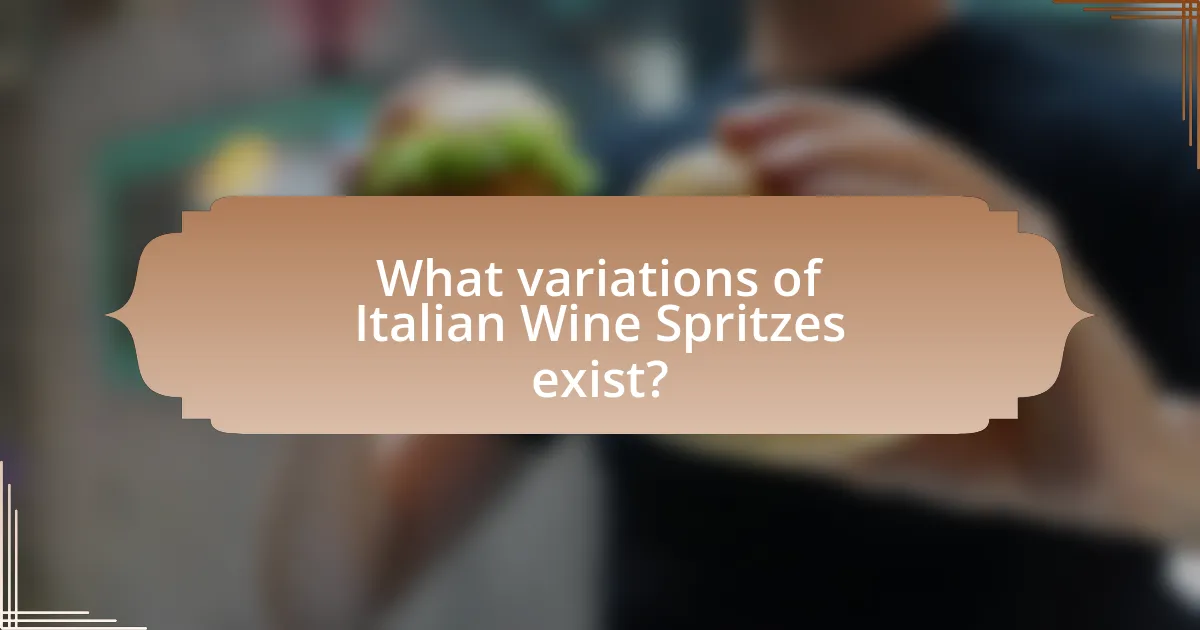
What variations of Italian Wine Spritzes exist?
Variations of Italian Wine Spritzes include the classic Spritz Veneziano, which combines Prosecco, Aperol, and soda water; the Spritz Bianco, made with white wine and elderflower liqueur; and the Spritz Rosso, featuring red wine and Campari. Each variation offers a unique flavor profile, reflecting regional preferences and ingredients. The classic Spritz Veneziano is particularly popular in Venice, while the Spritz Bianco is favored in northern Italy, showcasing the diversity of Italian wine culture.
How do regional differences affect Italian Wine Spritz recipes?
Regional differences significantly influence Italian Wine Spritz recipes by determining the choice of base wines, mixers, and garnishes used in each area. For instance, in Veneto, the traditional Spritz is made with Prosecco, while in regions like Friuli-Venezia Giulia, local wines such as Friulano may be preferred. Additionally, the use of different bitters, such as Aperol or Campari, varies by region, affecting the flavor profile. This regional variation is rooted in local wine production, cultural preferences, and historical practices, showcasing Italy’s diverse culinary landscape.
What are some popular regional variations of Italian Wine Spritzes?
Popular regional variations of Italian Wine Spritzes include the Aperol Spritz from Veneto, the Campari Spritz from Lombardy, and the Select Spritz from Venice. The Aperol Spritz, made with Aperol, Prosecco, and soda water, is widely recognized and celebrated for its vibrant orange color and bittersweet flavor. The Campari Spritz, featuring Campari, Prosecco, and soda, offers a more intense bitterness and is popular in northern Italy. The Select Spritz, a lesser-known variation, uses Select Aperitivo, Prosecco, and soda, providing a unique taste profile that reflects Venetian traditions. These variations highlight the regional preferences and ingredients that contribute to the diversity of Italian spritzes.
How do local ingredients shape these variations?
Local ingredients significantly shape variations of Italian wine spritzes by influencing flavor profiles and regional characteristics. For instance, the use of local wines, such as Prosecco from Veneto or Aperol from Padua, directly impacts the taste and authenticity of the spritz. Additionally, the incorporation of regional herbs, fruits, and bitters enhances the drink’s uniqueness, reflecting local agricultural practices and culinary traditions. This connection to local ingredients not only preserves cultural heritage but also caters to local palates, making each spritz variant a representation of its geographical origin.
What are the most popular Italian Wine Spritzes worldwide?
The most popular Italian wine spritzes worldwide include the Aperol Spritz, Campari Spritz, and Hugo Spritz. The Aperol Spritz, made with Aperol, Prosecco, and soda water, is particularly renowned for its vibrant orange color and refreshing taste, making it a staple in bars globally. The Campari Spritz, featuring Campari, Prosecco, and soda, offers a more bitter flavor profile, appealing to those who enjoy a stronger taste. The Hugo Spritz, which combines elderflower syrup, Prosecco, and mint, has gained popularity for its floral notes and is especially favored in Northern Italy. These spritzes have become iconic representations of Italian aperitivo culture, contributing to their widespread recognition and enjoyment across various countries.
Which Italian Wine Spritzes have gained international acclaim?
The Italian wine spritzes that have gained international acclaim include the Aperol Spritz and the Campari Spritz. The Aperol Spritz, made with Aperol, Prosecco, and soda water, has become a global favorite, particularly known for its vibrant orange color and refreshing taste. The Campari Spritz, featuring Campari, Prosecco, and soda, is recognized for its bitter-sweet flavor profile and has also garnered a significant following worldwide. Both spritzes are emblematic of Italian aperitivo culture and have been featured in numerous cocktail menus across the globe, contributing to their international popularity.
What makes these spritzes stand out in the global market?
Italian wine spritzes stand out in the global market due to their unique blend of refreshing flavors, versatility in mixology, and cultural heritage. The combination of sparkling wine, bitters, and soda creates a light, effervescent drink that appeals to a wide audience, making it popular in various social settings. Additionally, the rise of the aperitivo culture in Italy has influenced global drinking trends, with spritzes becoming synonymous with relaxation and socializing. This cultural significance, along with the increasing demand for low-alcohol beverages, has contributed to their growing popularity worldwide.
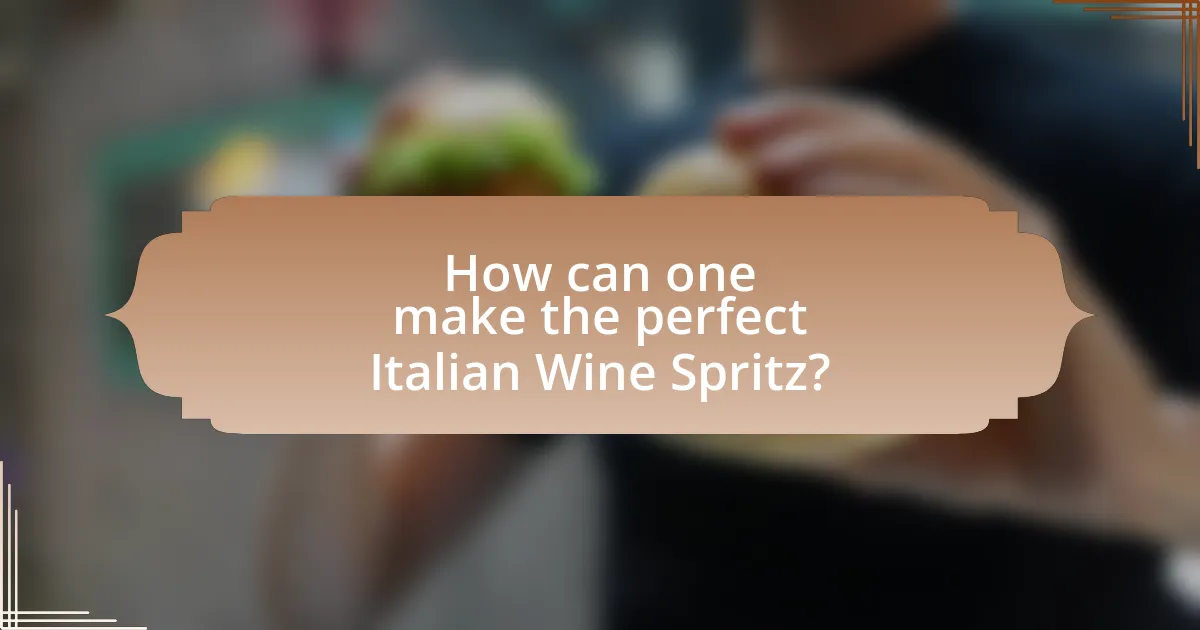
How can one make the perfect Italian Wine Spritz?
To make the perfect Italian Wine Spritz, combine three parts Prosecco, two parts Aperol, and one part soda water over ice in a wine glass. This classic ratio creates a balanced flavor profile that is refreshing and aromatic. The use of Prosecco, a sparkling wine from Italy, contributes to the drink’s effervescence, while Aperol adds a distinct bitter-sweetness, and soda water lightens the overall taste. This combination has been popularized in Italy, particularly in the Veneto region, where the Spritz originated, making it a staple in Italian aperitivo culture.
What are the essential steps to prepare an Italian Wine Spritz?
To prepare an Italian Wine Spritz, follow these essential steps: First, fill a wine glass with ice cubes. Next, pour three parts of Prosecco, two parts of Aperol or Campari, and one part of soda water over the ice. Stir gently to combine the ingredients. Finally, garnish with an orange slice for added flavor. This method is widely recognized for creating a refreshing and balanced drink, popularized in Italy and now enjoyed globally.
What tips can enhance the flavor of an Italian Wine Spritz?
To enhance the flavor of an Italian Wine Spritz, use high-quality ingredients, such as a premium Italian white wine and fresh, seasonal garnishes. The choice of wine significantly impacts the overall taste; for instance, using a crisp Prosecco can add a refreshing effervescence. Additionally, incorporating fresh herbs like basil or mint can introduce aromatic complexity, while citrus slices, such as orange or lemon, provide a zesty brightness. The balance of the spritz can also be improved by adjusting the ratio of wine to soda water, typically aiming for a 3:1 ratio, which allows the wine’s flavors to shine without being overpowered. These tips are supported by the popularity of spritz variations in Italy, where local ingredients are often emphasized to create a more vibrant and flavorful drink.
How can garnishes elevate the presentation of Italian Wine Spritzes?
Garnishes can elevate the presentation of Italian Wine Spritzes by adding visual appeal and enhancing the overall sensory experience. For instance, a slice of orange or a sprig of rosemary not only complements the drink’s color but also introduces aromatic elements that enhance the flavor profile. Research indicates that visual presentation significantly influences consumer perception and enjoyment of beverages, with garnishes serving as a key factor in creating an inviting and sophisticated appearance. This combination of aesthetics and aroma makes garnishes essential for elevating the experience of Italian Wine Spritzes.
What common mistakes should be avoided when making Italian Wine Spritzes?
Common mistakes to avoid when making Italian Wine Spritzes include using the wrong proportions of ingredients, which can lead to an unbalanced flavor. The classic recipe typically calls for three parts Prosecco, two parts Aperol or Campari, and one part soda water. Additionally, using flat or stale soda water diminishes the spritz’s refreshing quality, while neglecting to chill the ingredients beforehand can result in a less enjoyable drink. Lastly, garnishing with the wrong herbs or fruits, such as using overly sweet fruits instead of the traditional orange slice, can alter the intended taste profile.
How can improper ingredient ratios affect the taste?
Improper ingredient ratios can significantly alter the taste of Italian wine spritzes, leading to an unbalanced flavor profile. For instance, using too much bitter aperitif can overwhelm the drink, making it excessively bitter, while insufficient sparkling wine can result in a flat and dull taste. Studies show that the ideal ratio for a classic spritz is typically three parts sparkling wine to two parts aperitif and one part soda water; deviations from this can disrupt the intended harmony of flavors. This imbalance can detract from the refreshing qualities that make spritzes popular, ultimately affecting consumer enjoyment and preference.
What are the pitfalls of using low-quality ingredients?
Using low-quality ingredients can lead to inferior taste, compromised health benefits, and negative consumer perceptions. Low-quality ingredients often lack the flavor complexity and freshness that high-quality components provide, resulting in a less enjoyable drinking experience. Additionally, these ingredients may contain harmful additives or lower nutritional value, which can affect the overall healthiness of the beverage. Research indicates that consumers are increasingly aware of ingredient quality, with studies showing that 70% of consumers prefer products made with high-quality, natural ingredients, impacting brand loyalty and sales negatively for those using inferior components.
What are some creative twists on traditional Italian Wine Spritzes?
Creative twists on traditional Italian Wine Spritzes include variations such as the Aperol Spritz with blood orange juice, which adds a unique citrus flavor, and the Elderflower Spritz, combining prosecco with elderflower liqueur for a floral note. Another innovative option is the Campari Spritz, which uses Campari instead of Aperol, resulting in a more bitter profile. Additionally, incorporating fresh herbs like basil or mint can enhance the aromatic experience, while using flavored sparkling waters, such as grapefruit or cucumber, introduces refreshing elements. These adaptations maintain the essence of the original spritz while offering new taste experiences.
How can seasonal ingredients be incorporated into Italian Wine Spritzes?
Seasonal ingredients can be incorporated into Italian Wine Spritzes by using fresh fruits, herbs, and vegetables that are in season, enhancing both flavor and presentation. For example, in spring, strawberries and basil can be added for a refreshing twist, while summer might feature peaches or watermelon for a light, fruity profile. Autumn can bring in apples or pears, and winter can utilize citrus fruits like blood oranges or grapefruits. This practice not only aligns with the farm-to-table movement but also ensures that the ingredients are at their peak flavor and nutritional value, making the spritzes more vibrant and appealing.
What innovative flavor combinations can be explored?
Innovative flavor combinations that can be explored include Aperol with grapefruit and rosemary, Prosecco with elderflower and cucumber, and Campari with blood orange and basil. These combinations enhance the traditional Italian spritz by introducing unique herbal and citrus notes, appealing to modern palates. Research indicates that the infusion of fresh herbs and unconventional fruits can elevate the sensory experience of cocktails, making them more refreshing and complex. For instance, a study published in the Journal of Culinary Science and Technology highlights how the addition of herbs can significantly alter flavor profiles, creating a more dynamic drinking experience.
